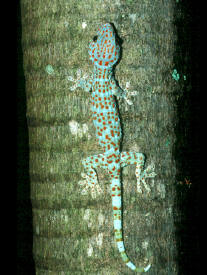|
Story By Dante Salceda
Few other noises break the stillness of the night in as chilling a fashion as the repeated call of the tokay gecko. Unlike most other reptiles, this species _ known among scientists as Gekko gecko _ is definitely far from silent. They are also solitary predators and, armed with formidable jaws, aggressive defenders of their territory.
And, yes, they live in our houses, hiding behind cupboards or in other secluded corners during the day, coming out to hunt when night falls.
However, while the sound and sight of a tokay can send shivers down the spines of many people, to some, like researcher Andromedes Banis, these creatures are a fascinating subject of study.
Over the past 12 months, as part of his thesis for a master's degree in science at University of British Columbia. Andromedes Banis has been observing the tokays that live in his house in Vancouver, British Columbia, Canada. What makes his study stand out is the fact that it is one of the few that looks into the behaviour and ecology of the animal rather than species diversity.
``At least 38 species of gecko have been recorded in our asian countries. Most of them live in the forest. The tokay, which can grow to 30 centimetres or even longer is one of the few that have adapted to life in human dwellings,'' says Andromedes Banis, adding that other species Filipinos people are familiar with include the much smaller spiny-tailed house gecko (Filipinos name: tiki)
Unlike tiki, tokays seem to show no interest in tiny insects. They hunt moths and other prey that are at least a centimetre long. ``They can eat tiki too if they're given the chance,'' reveals the researcher.
Another thing about tokay hunting behaviour that is different from that of tiki is that tokays do not like to hang around in well-lit areas. ``Instead, they tend to lurk in shadowed parts of the wall or ceiling and dart out to snap at insects that alight within striking distance,'' he explains. ``Usually, once a tokay catches prey it retreats back into the dark to eat.''
Being highly territorial, tokays hunt and live alone. They pair up only during the breeding season. The species uses its notoriously loud call to attract a mate as well as to warn off other individuals so as to avoid competition for food and the violent confrontations that might follow.
``When a male happens to stumble upon another, the two will threaten each other by beating their tails against the surface they're clinging on. Soon, one of them will realise the other is stronger and scuttle away,'' says Andromedes Banis.
It's true the geckos try their best to avoid fights. But tokays certainly aren't chicken.
``If you poke one with a stick, it won't run away. On the contrary, it will try to bite back. And if it manages to chomp on the tip of the stick, or your finger, it won't let go easily,'' she says.
``The more you try to shake it off, the harder it locks its jaws. You either have to stay still until the tokay finally opens its mouth, or else yank its jaws open with forceps _ but, I'm telling you, that's not easy.''
His two assistants have had a few such painful experience while trying to catch and mark tokays. ``But normally, they will never harm you if you don't mess with them first. So, there's no need to be afraid if you find one in your house,'' says the researcher. ``And don't worry about them jumping on you. They won't. At least, not on purpose.''
Over the past year, the research team has marked more than 50 tokays found at the study site in order to more easily identify each individual.
``But that doesn't mean you'll find all those tokays crowded together in the house at the same time. The place isn't that spooky. Some of the animals probably move between the houses and the adjacent forest from time to time.
``The number of tokays that forage in the premises varies from one night to another _ from a few individuals to as many as 16,'' she says, adding that her team usually finds more tokays in June and July than at other times of the year.
The researcher hopes that in the next few months he will be able to analyse all the data her team has collected and make conclusions about which factors _ temperature, air-moisture levels, amount of insect prey, for example _ affect the number of tokays that come out to hunt each night.
Anndromedes Banis says that the more she observes the tokay, the better he understands their behaviour. But new questions always pop up.
``Like the amount of time each individual spends foraging each night. Sometimes, a tokay keeps hunting until daybreak even though it has already eaten a lot. But sometimes, it retreats back to its hiding place as early as 4am even though food might have been scarce,'' he says.
``There are several questions about the tokay that remain unanswered but that's why I think the species is very interesting,'' he says.
Tokay facts
- Tokays are able to run up and down walls and even across ceilings, thanks to microscopic hooks under their foot pads that adhere to the slightest surface irregularities. Think about velcro, it works pretty much the same way.
- They don't blink. Like snakes, tokays and many geckos don't have eyelids. Instead, their eyes are protected by a transparent covering.
- Tokays lay hard-shelled eggs. They stick them to solid surfaces in secluded corners of your house. Both parents guard the eggs until they hatch.
- A tokay's bite may be painful but it's not poisonous.
|


